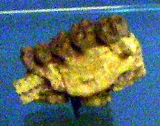
Samburupithecus
Encyclopedia
Samburupithecus was a primate
that lived in Kenya
during the middle to late Miocene
. The one species in this genus, Samburupithecus kiptalami, is known only from a maxilla fragment dated to 9.5 Ma discovered by Hidemi Ishida and Martin Pickford in 1997. Samburupithecus was approximately 60 kg and was most likely a frugivorus terrestrial quadruped (Fleagle, 1999). Paleoenvironmental reconstructions indicate that Samburupithecus most likely lived in a wooded habitat surrounded by savannah
(Tsujikawa, 2005).
Defining cranial traits of this genus include low, broad zygomatics
, straight alveolar process and large maxillary sinus
. Defining dental traits include three-rooted premolars, thick enamel
and buonodont cusps (Ward, 2002). Unlike many other Miocene hominoids, Samburupithecus has teeth that are elongated from front to back. This feature links the taxon to gorilla
s, chimpanzee
s and hominins, but its relationships within this clade
are presently unknown (Fleagle, 1999).
Primate
A primate is a mammal of the order Primates , which contains prosimians and simians. Primates arose from ancestors that lived in the trees of tropical forests; many primate characteristics represent adaptations to life in this challenging three-dimensional environment...
that lived in Kenya
Kenya
Kenya , officially known as the Republic of Kenya, is a country in East Africa that lies on the equator, with the Indian Ocean to its south-east...
during the middle to late Miocene
Miocene
The Miocene is a geological epoch of the Neogene Period and extends from about . The Miocene was named by Sir Charles Lyell. Its name comes from the Greek words and and means "less recent" because it has 18% fewer modern sea invertebrates than the Pliocene. The Miocene follows the Oligocene...
. The one species in this genus, Samburupithecus kiptalami, is known only from a maxilla fragment dated to 9.5 Ma discovered by Hidemi Ishida and Martin Pickford in 1997. Samburupithecus was approximately 60 kg and was most likely a frugivorus terrestrial quadruped (Fleagle, 1999). Paleoenvironmental reconstructions indicate that Samburupithecus most likely lived in a wooded habitat surrounded by savannah
Savannah
Savannah or savanna is a type of grassland.It can also mean:-People:* Savannah King, a Canadian freestyle swimmer* Savannah Outen, a singer who gained popularity on You Tube...
(Tsujikawa, 2005).
Defining cranial traits of this genus include low, broad zygomatics
Zygomatic bone
The zygomatic bone is a paired bone of the human skull. It articulates with the maxilla, the temporal bone, the sphenoid bone and the frontal bone. The zygomatic is homologous to the jugal bone of other tetrapods...
, straight alveolar process and large maxillary sinus
Maxillary sinus
The pyramid shaped maxillary sinus is the largest of the paranasal sinuses, and drains into the nose. It is present at birth as rudimentary air cells, and develops throughout childhood.-General characteristics:...
. Defining dental traits include three-rooted premolars, thick enamel
Tooth enamel
Tooth enamel, along with dentin, cementum, and dental pulp is one of the four major tissues that make up the tooth in vertebrates. It is the hardest and most highly mineralized substance in the human body. Tooth enamel is also found in the dermal denticles of sharks...
and buonodont cusps (Ward, 2002). Unlike many other Miocene hominoids, Samburupithecus has teeth that are elongated from front to back. This feature links the taxon to gorilla
Gorilla
Gorillas are the largest extant species of primates. They are ground-dwelling, predominantly herbivorous apes that inhabit the forests of central Africa. Gorillas are divided into two species and either four or five subspecies...
s, chimpanzee
Chimpanzee
Chimpanzee, sometimes colloquially chimp, is the common name for the two extant species of ape in the genus Pan. The Congo River forms the boundary between the native habitat of the two species:...
s and hominins, but its relationships within this clade
Clade
A clade is a group consisting of a species and all its descendants. In the terms of biological systematics, a clade is a single "branch" on the "tree of life". The idea that such a "natural group" of organisms should be grouped together and given a taxonomic name is central to biological...
are presently unknown (Fleagle, 1999).
See also
- List of fossil sites (with link directory)
- List of hominina (hominid) fossils (with images)

